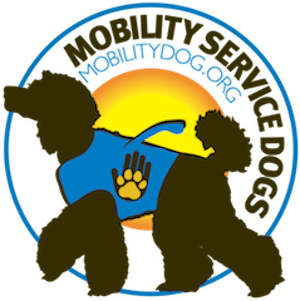How to Understand Dog Body Language: Your Dog's Eye Contact
Black and White Poodle Laying among Yellow Daffodils (Courtesy: MobilityDog.org)
Of the many jobs you have as your pup’s human guardian, interpretation of the dog’s communication is high on the list. As with humans, a dog’s eyes are a window into its inner state; a window we must peer through to understand how our dogs view us and our world.
One More Way Dogs Differ from Wolves
When your dog gazes at you with big puppy eyes, she’s demonstrating an ability that evolved over the period of canine domestication by humans. Domestication influenced the anatomy of dogs’ facial muscles so they could communicate better with their human companions. A study produced by the National Academy of Sciences reported that, unlike wolves, dogs can raise their inner eyebrows noticeably. The resulting expression appears to convey what humans interpret as sadness or melancholy, which may in turn engender a sympathetic or nurturing response. Scientists hypothesize that evolution selected for this trait because it built bonds with humans that contributed to the canines’ ability to thrive in human company.
“The mutual gaze between dogs and humans seems to be a hallmark of the unique relationship between both species during human cultural evolution,” the researchers wrote. Gazing into each other’s eyes seems to trigger an increase in oxytocin, a hormone that plays a role in social bonding.
Hard and Soft Eye Contact
Aside from puppy eyes, dogs can use their eyes to send an array of nuanced messages. For example, if the dog’s eyes are round or almond-shaped and soft, with the pupils dilated appropriately for the ambient light (small pupils if light is bright, large if light is dim), you’re dealing with a calm and happy animal. Conversely, a hard stare should put you on alert – this is not a sign of friendship. Accompanying body language is usually assertive – the dog may be standing tall and leaning forward, with the tail erect or wagging stiffly. The dog may even go completely still and be ready to bite.
Avoiding Eye Contact
Among canines, direct eye contact sometimes indicates a threat. Often, you’ll notice your dog looking away when you focus directly on her. This is a sign of deference. The dog is telling you she has no intention of challenging you as the alpha of the household. She’s displaying good doggie manners and being non-confrontational.
Whale Eye
Dog trainers use this term when they see an animal dramatically showing the whites of its eyes. A direct, wide-eyed stare with lots of white around the pupils may foreshadow significant aggression. Whale eye may also merely mean the dog is looking sideways with her nose pointed forward. Dogs who tend to guard toys and food may make his expression as they point their noses at the resource they are protecting while also trying to gauge how much of a threat you are to their valued thing.
Look at Your Dog’s Entire Body
Eye contact is important in interpreting your pet’s mental state, but don’t forget that the rest of Fido’s body is also a rich palette of messages. Facial expressions don’t always convey their intentions – often, our pets are simply letting us know how they feel at a particular moment. Consider their posture, plus what you see happening around their ears, tail and mouth.
With whale eye, for example, the rest of the dog’s body language is key to knowing when you’re seeing a sign of aggression and when you aren’t. If the body is relatively still and forward, it’s aggression. If other body signals indicate relaxation and play, then it is likely not benign.
Dog body language always occurs within a context; understanding circumstances is critical to interpreting any specific action or expression. Yawning, for example, may mean your dog is tired, but equally often it is a sign of fear or stress. Likewise, lip-licking may be a grooming behavior, but it too can signal anxiety or fear. To experience the full richness of a dog’s facial expressions and body language, pay attention to the animal’s surroundings and to the other animals (human, canine and other) in the vicinity. And, most of all, know your pet. Her way of communicating with you will probably be individualistic and idiosyncratic. It’s part of her way of bonding with you the way she does with nobody else.

